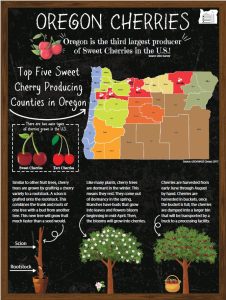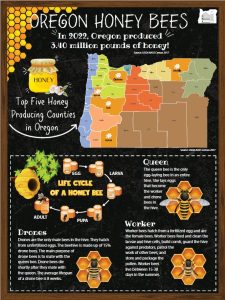This 2-sided 18×24″ poster features Oregon’s cherry industry and the life cycle of Honey bees. A great additional to celebrate the upcoming Spring season.


This beautiful 8.5 x 11 inch full color map of Washington County features unique commodities grown in the county. It is an excellent tool to bring a piece of the story one County plays in Oregon’s agricultural diversity to the classroom.
The Grown in Washington County Map helps students visualize where things are grown right in their backyard. On the back of the map student’s can learn some more information about the unique commodities grown in the County and how they support the diversity of Oregon agriculture.
Maps are free to Oregon teachers. If you would like a classroom set please let us know how many to send!
Lynne Boddy
Did you know that fungi are made to make medicine for humans? Or that the most mushrooms can be seen in autumn? This picture book about nature is packed with fun facts about fungi. It includes gross-out stories of fungal infections that kids will love, incredible facts about “bananageddon”, crop disease, epidemics, and zombified ants! It’s the ultimate gift for children who are interested in nature and microorganisms. Book must be returned.
Catherine O'Neil Grace, Margaret M. Bruchac, Plimoth Plantation
Countering the prevailing, traditional story of the first Thanksgiving, with its black-hatted, silver-buckled Pilgrims; blanket-clad, be-feathered Indians, this lushly illustrated photo-essay presents a more measured, balanced, and historically accurate version of the three-day harvest celebration in 1621. Pair this with resources teaching about harvest traditions specific to Oregon tribes!
A Classroom set is is 15 copies of the book. Must Be returned.
Kim Binczewski & Bethany Econopouly
It’s a sleepy Saturday morning for most people, but not for Iris, who has to feed her many pets before Aunt Mary arrives. Iris likes to call Aunt Mary “Plant Mary” because she is a plant scientist.
Today Aunt Mary wants to experiment with making whole wheat sourdough bread from scratch! As the family kitchen transforms into a bread lab, Iris is surprised that bread needs only four ingredients―flour, water, salt and starter. She also learns about the invisible microbes that make the dough rise, and how flour comes from wheat grown by farmers. It all seems magical, but it’s really science. This book needs to be returned.
Jodi Icenoggle
Gillian Doherty
Invites young readers to find various quantities of such things as farm animals and tools which are labeled in the illustrations of rural scenes, including a sheep farm, an orchard, a rice paddy, and bee hives. This book needs to be returned.
Peter Riley
This series is an introduction to the key science subjects, explaining the main scientific principles and showing how they work. Plant Life details the variety of plants in the world and how they grow and fertilize.’
This book must be returned
Grow your own necklace! This kit contains materials for your students to plant a seed in a jewel bag attached to yarn, thus creating a “living necklace.” Given time and water, the necklace will be alive with a growing sprout in a few days. An excellent activity for teaching plant growth requirements. Kit includes: yarn, cotton ball, bean seed and plastic bag. Click here for lesson plan.
This kit does not need to be returned.
This Kit Includes:
Yarn, beans, jewel bags, cotton balls, and a paper lesson plan
Please put the number of students in your class in the quantity section at checkout to ensure the correct number of supplies gets to you.
Cris Peterson
Seed. Soil. Sun. With these simple ingredients, nature creates our food. This beautifully written book by Cris Peterson, brings both wonder and clarity to the subject of agriculture, celebrating the cycle of growth, harvest, and renewal. The photography that conveys this story is a perfect fit for this story. The companion book to the Seed, Soil, Sun lesson plan and the Seed, Soil, Sun Kit. Please check the kit out separately.